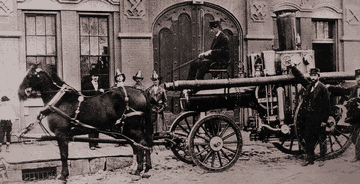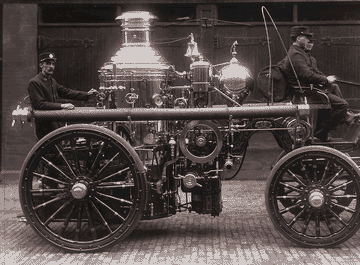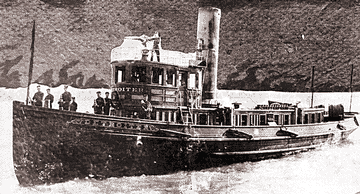The Detroit Fire Department's 130 years of flames and heroics
By Patricia Zacharias
On June ll, l805, a blaze touched off in a stable by a spark from the pipe of a baker's helper, roared through the community of wooden buildings, leveling the century-old city of Detroit. The danger of fire was a constant concern for residents. An ordinance required every citizen to have a full water barrel and two buckets ready. Regular chimney sweeping was ordered as well as having ladders from ground to roof. Often during a blaze, bucket brigades of men, women and children formed to move water from the river to the fire.

An army of volunteer bucket, ax and battering-ram companies evolved as the boundaries of the city expanded. These volunteer fire companies were loosely knit clubs whose members loved to socialize and dress up in smart uniforms. The city provided hand-operated pumping engines but the firemen were responsible for everything else. Their lack of discipline was notorious; rivalry between the companies bitter.

In l860, the city fathers hastily hired Detroit's first paid fire fighters, an engineer, five hosemen, two drivers and a foreman to operate the first steam fire engine. The engine cost the city $3,l50 and was delivered from the Amoskeag Manufacturing Company of Manchester, N.H. It was named "Lafayette No. 1" and was housed on the northeast corner of Larned and Wayne streets. Neptune No. 2 steam engine and Phoenix No. 3 were purchased the following year. In l867, an act of the Michigan State Legislature established the Board of Fire Commissioners. The following year, a successful telegraph fire alarm system was installed.
When the Great Chicago Fire broke out in October of l87l, frantic Chicago officials called for help from a number of cities including Detroit. Engine companies No. 3 and No. 6 were dispatched. They went by freight train to Chicago. The journey took three days to get there because of blocked tracks. They remained in Chicago for ten days.
Since Detroit grew up along the waterfront, the need for fireboats emerged. The city's first fireboat, the Detroiter, built by the Craig Shipbuilding Company, went into service in the summer of l892. Dry rot set in a few years later. In l902, its fire fighting equipment was transferred to the new steel- hulled James R. Elliot, named after Detroit's second fire chief. The custom of naming fireboats after early chiefs began in l900, when the James Battle joined the Detroiter on the river. Later, Detroit's third fire chief, John Kendall, was honored by a boat built in l930 to replace the Elliot.
In 1948 the Kendall crossed the international border, never considered a barrier in a time of crisis, to help extinguish a spectacular fire raging in the waterfront buildings of the Canadian Pacific Railway in Windsor.
By l900, the population of the city had grown to 308,000. The fire department consisted of 476 paid firemen, one fireboat, 423 fireboxes, 3,609 hydrants and 76 pieces of horse-drawn equipment.
It seemed as if the fire horse would remain a vital part of the fire department forever. No one considered it a threat when the first automobile, a Carter two-seater, was purchased in l906. The firemen joked about the ridiculous purchase. They nicknamed it the 'Hustle Buggy'. Other horseless purchases followed.

The Detroit department acquired the first motor fire engine in the world, a Packard. A fury of objections by firefighters and Detroiters over their beloved horse's replacement continued for several years. The horse, it was argued, was much more reliable. The motorized vehicles were hard-starting and breakdowns too frequent.
By l922, the age of mechanization had arrived. The future of the fire horse was doomed. The tough decision was made to retire the fire department's horses. On April 10, l922, more than 50,000 people turned out to witness the historic last run. The city's last five fire horses, Pete, Jim, Tom, Babe and Rusty, made their final dash down Woodward Avenue as a make-believe alarm sounded at the National Bank Building. Spectators lining the streets cheered as the fire department's band played 'Auld Lang Syne'. Many in the crowd, according to The News, cried as the horses passed. These last five hooved fire fighters were retired to an "Equine Elysium" in River Rouge Park.
Over the years, barriers were broken. In l938, Marcena W. Taylor and Marvin White became the first black members of the department. In l952, Taylor became the first black officer. The Fire Commission appointed Taylor Sergeant at Ladder Company No. 4.
In l976, amidst public outcry, the order came down for the banishment of dog mascots at engine houses. Commissioner Melvin Jefferson argued that dogs might frighten citizens and that legal actions by a "bitten visitor" might follow. The age of "legalese" had arrived.
The all male uniform force was altered when Sandy Kupper was awarded Badge No. l437 in l978 and instantly became, as she described it, "one of the boys". Sandy was among the first three women in the department's history to graduate from the Fire Academy, and the first of those three to complete the four-month probationary tour.
In the early 1980's Detroiters once again lived in fear of fire as Devil's night arson gained national and international attention. The numbers peaked in 1984 at 810. In recent years sanity returned to the city as volunteers join with the fire department to save their neigborhoods.
